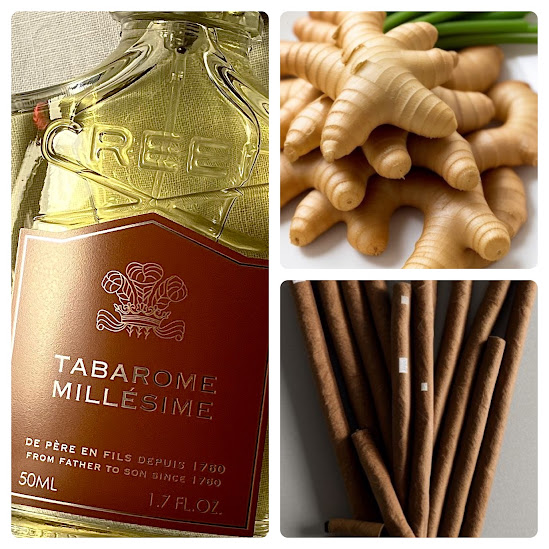This is both the second part of my meditation and a review of Tabarome Millésime. Here’s the crux of it: Tabarome Millésime is the most important Creed of the 2000s, and yet no one discusses it. Before you dismiss this claim, hear me out, and then draw your own conclusions. My argument rests on a theory that ties this Creed fragrance to one of the biggest successes of 2010—a wildly popular Chanel, recognizable by its name and its signature "blue" hue.
To be clear, I’m referring to the years 2000 to 2009. Several notable Creeds came out during that decade, including Himalaya, Original Vetiver, Santal, and Virgin Island Water. While these other scents were derivative, Tabarome Millésime was a precursor to greater things. Most intriguingly, it defies its brown label and tan-green liquid. Instead, it smells like a rough draft of Bleu de Chanel—a very rough draft, mind you, but all the essential elements are present. There’s a sweet touch of citrus, followed by ginger, sandalwood, black tea, and green tobacco leaf. Hints of vetiver and mild smokiness are nestled within, while the sandalwood, dry and pale, echoes a birch note. Strangely enough, Tabarome Millésime feels more "blue" than Bleu itself.
Its resemblance to Bleu de Chanel is both fascinating and unsettling. From what I can gather, Olivier Creed is the actual perfumer behind Tabarome Millésime—not a "ghost perfumer" like Pierre Bourdon or Jean-Christophe Hérault. If this is true, it’s a monumental fact, more significant than most realize. Amidst the accusations of Olivier’s perfume “theft” and dubious business tactics, and the widespread belief that he’s more of an "evaluator" than a creator, we find ourselves in complicated territory. If Olivier’s 2000 release indeed paved the way for Chanel’s blockbuster a decade later, then he is far from inconsequential. In fact, he might even be a visionary.
So, what makes Tabarome Millésime smell vaguely "blue"? It opens with a sharp, sour citrus accord, bracing and almost unpleasant in its tartness—bergamot with a lime-like bite, only slightly softened by sweet mandarin. The ginger that follows isn’t as effervescent as I expected, but it’s deeper and rounder than anything I’ve encountered in a designer fragrance. Beneath the ginger, black tea, sandalwood, smoky-salty ambergris, and raw tobacco leaf emerge, all resting on a base of petitgrain and white musk. The composition is simple, lacking contrast and dynamism, presenting more as a single, multi-faceted note—ginger with a few supporting elements. The freshness, likely from ambergris and a cool, aqueous musk, combined with the ginger, gives the fragrance its "blue" character, evoking the sensation of crisp water and clear air.
Some reviews suggest Tabarome Millésime is ideal for the office or for older men. Luca Turin called it a "sport fragrance" and dismissed it as "mislabeled and pointless." Given how faint the tobacco note is, it might indeed be mislabeled, but pointless? I beg to differ. The gingery woods at the heart of this scent, a concept later mastered by Jacques Polge in a world-shattering perfume, carry considerable weight within the realm of masculine fragrances. One Fragrantica reviewer compared it to Dirty English by Juicy Couture, and I see the resemblance. Ironically, I’ve compared Dirty English to Bleu de Chanel in the past, referring to it as "Brun de Chanel"—Dirty English smells earthy and brown, with a streak of blue running through it. It shares enough DNA with Bleu that I view it as another stepping stone toward the final 2010 iteration of this idea. Masculine perfumery evolves in stages, a few years at a time.
Why does Dirty English evoke a color? Once again, we find the same combination of notes that parallels Tabarome Millésime and Bleu de Chanel: cedar, vetiver, smoky woods (perhaps "oud"), and a sharp, synthetic citrus note that doesn’t resemble real fruit but feels like a technicolor image of one. ISO E Super is just as prominent as the esters and aldehydes. Though far from an aquatic or ozonic fragrance, and certainly not marketed as one, Dirty English achieves a distinct "blue" tone, a fresh yet somber quality that echoes in Chanel’s later creation. To be clear, Bleu de Chanel is the most refined of these three, while Tabarome Millésime, despite its high-quality ingredients, suffers from an inferior composition and balance. Olivier’s scent feels too evenly spread, with the notes never truly playing off each other. In contrast, Dirty English, the cheapest of the trio, smells livelier—but it’s a zephyr next to Bleu de Chanel's tempest.
All of this leads to one conclusion: the best "blue" fragrances evoke the color itself, and the tranquility it suggests, without relying on tired aquatic or synthetic accords. The "blue" quality of Bleu de Chanel, Tabarome Millésime, and Dirty English stems from their ability to conjure a mood—a certain quiet, misty atmosphere, the austere beauty of nature in the early morning, before the light fully dispels the night. These fragrances inspire the sensation of a color rather than a seascape or a sunlit beach. The genius lies in the perfumer’s ability to distill this achingly familiar feeling into a scent, one that transports us to that place we all recognize as "blue."




.jpeg)

